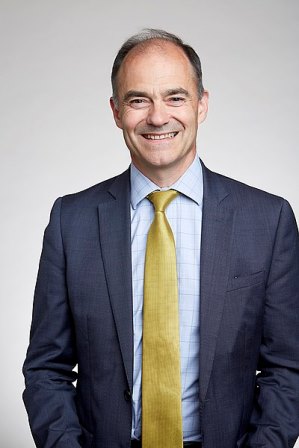
Rolls-Royce CEO Warren East. Image source: Wikipedia
An interview of the Rolls-Royce CEO provides some valuable lessons on how not to act during a media interview.
Rolls-Royce CEO Warren East stared off camera and appeared to smirk during a media interview about lay-offs at the company. The aviation giant had just announced plans to lay off 9,000 employees.
Unfavorable newspaper headlines highlighted his smirk. Reaction on social media was brutal, with commentators calling Warren unprofessional, obnoxious and callous.
Either the @rollsroycecars CEO is having a Diane Abbot moment with the numbers, or his mate is drawing a huge willy on the whiteboard.
Either way, not a brilliant look….#RollsRoyce
— Sam Goodhand (@SamGoodhand) May 20, 2020
East later apologized for his interview performance, acknowledging that he came across poorly. He said he was caught off guard by the figures the broadcast journalist mentioned and looked to a colleague off-camera to see if he properly understood the question.
The performance violates key tenants of media interviews in general and online interviews in particular, as media trainer James White at Media First points out.
Don’t smile. Smiling while delivering bad news is a media relations faux paus. A PR crisis is no time to smile. CEOs typically try to appear optimistic and congenial during public appearances, but smiling while delivering bad news or corporate apologies means the message is sure to flop. Research that examined 29 online videos of CEO apologies found that more smiles correlated to subsequent falling stock values. If the CEO looks sincerely sad, the company usually recovers quickly.
Keep your eye on the camera. East appeared shifty and lost credibility by looking away from the camera. PR experts recommend looking the interviewer in the eye.
In a remote interview, rather than looking at the on your screen, maintain eye-contact with the webcam, to create the impression of eye-contact, White advises. Communications professionals understand the need to remove distractions from the room during online media interviews. Interviews done from home in recent weeks have been interrupted by inquisitive children, noisy pets, and spouses in bathrobes. But distractions also include meddling PR advisers and press officers, White says.
“Having someone else in the room makes it much more likely that you will break that crucial eye contact with the webcam – you’ll naturally be looking to see how your colleague is reacting to what you are saying,” he says.
Get the right chair. The interview also reveals the risk of chairs that swivel or roll. While such chairs are standard office furniture, if your sit on such a chair during an interview, you’ll invariably change your position. That movement creates a huge distraction for the audience. A straight chair without wheels or a tilting back is best for an interview to help you sit erect and maintain the position directly in front of the camera. The erect position also helps you project better.
Bottom Line: The recent Rolls-Royce CEO media interview shows the importance of body language. Even if the answers are on target and well-framed, eye contact, momentary facial expressions and shifting in chairs can ruin an interview and damage the CEO’s reputation.
Download the 2020 Ultimate Guide to Media Monitoring, Measurement & Analytics for PR & Marketing
William J. Comcowich founded and served as CEO of CyberAlert LLC, the predecessor of Glean.info. He is currently serving as Interim CEO and member of the Board of Directors. Glean.info provides customized media monitoring, media measurement and analytics solutions across all types of traditional and social media.




